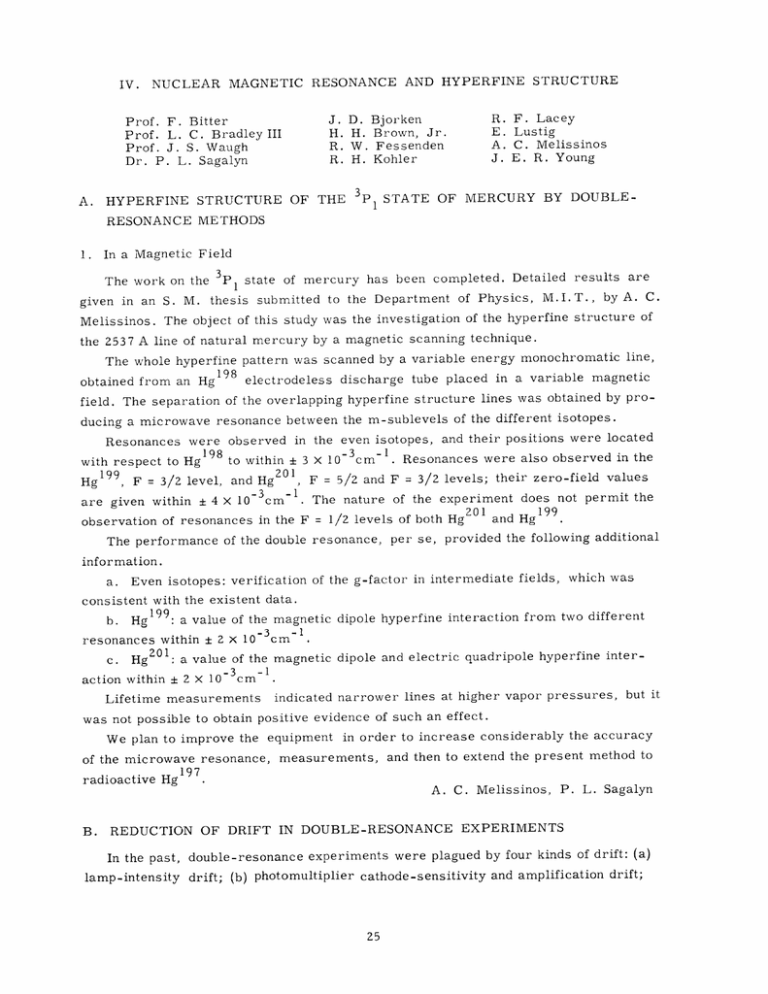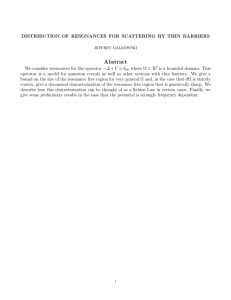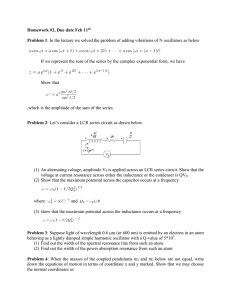IV. NUCLEAR MAGNETIC RESONANCE AND HYPERFINE ... Lacey R. F.
advertisement

IV. NUCLEAR RESONANCE AND HYPERFINE MAGNETIC A. HYPERFINE D. H. W. H. J. H. R. R. Prof. F. Bitter Prof. L. C. Bradley III Prof. J. S. Waugh Dr. P. L. Sagalyn STRUCTURE OF THE 3 R. E. A. J. Bjorken Brown, Jr. Fessenden Kohler p STRUCTURE F. Lacey Lustig C. Melissinos E. R. Young STATE OF MERCURY BY DOUBLE- RESONANCE METHODS 1. In a Magnetic Field The work on the given in an S. Melissinos. M. P 1 state of mercury has been completed. Detailed results are thesis submitted to the Department of Physics, M.I.T., by A. C. 3 The object of this study was the investigation of the hyperfine structure of the 2537 A line of natural mercury by a magnetic scanning technique. The whole hyperfine pattern was scanned by a variable energy monochromatic line, 19 8 electrodeless discharge tube placed in a variable magnetic obtained from an Hg field. The separation of the overlapping hyperfine structure lines was obtained by producing a microwave resonance between the m-sublevels of the different isotopes. Resonances were observed in the even isotopes, and their positions were located -1 -3 198 Resonances were also observed in the to within ± 3 X 10-3 cm-. with respect to Hg 20 1 Hg 1 9 9 , F = 3/2 level, and Hg-3i- , F = 5/2 and F = 3/2 levels; their zero-field values The nature of the experiment does not permit the are given within ± 4 x 10-3cm-1 201 199 and Hg observation of resonances in the F = 1/2 levels of both Hg The performance of the double resonance, per se, provided the following additional information. a. Even isotopes: verification of the g-factor in intermediate fields, which was consistent with the existent data. b. Hg 19 9 : a value of the magnetic dipole hyperfine interaction from two different resonances within ± 2 X 10 cm . Hg 2 0 1 : a value of the magnetic dipole and electric quadripole hyperfine inter-1 -3 action within ± 2 X 10 cm Lifetime measurements indicated narrower lines at higher vapor pressures, but it c. was not possible to obtain positive evidence of such an effect. We plan to improve the equipment of the microwave resonance, 197 radioactive Hg in order to increase considerably the accuracy measurements, and then to extend the present method to A. C. B. REDUCTION OF DRIFT IN DOUBLE-RESONANCE Melissinos, P. L. Sagalyn EXPERIMENTS In the past, double-resonance experiments were plagued by four kinds of drift: (a) lamp-intensity drift; (b) photomultiplier cathode-sensitivity and amplification drift; (IV. NUCLEAR MAGNETIC RESONANCE) Fig. IV-1. Diagram of the system. (c) photomultiplier dark-current drift; (d) gas-density drift in the resonance cell induced by change in temperature. Fluctuations that obscure or distort the desired microwave induced resonance are produced at the photomultiplier variations. output by these Some of the previously used methods of eliminating these difficulties are: (a) stabilization of the light source by control of the power supply and cooling; (b) temperature control of the resonance cell; (c) monitoring of the lamp intensity by a second photomultiplier. The elimination of drift is, in any case, limited by the natural photomultiplier noise level (1), whose signal-to-noise ratio is (i /2eAf) photocurrent, 1 / 2 , where i is the cathode e is the electronic charge, and Af is the bandwidth of the detector. This expression is, of course, equal to (En/2Af)1/2, where n is the number of photons per unit time arriving at the photocathode, and c is the efficiency of the photocathode. A suggested drift-reducing measurement method is shown in Fig. IV-1. The two switches are ganged, are operated at some fixed frequency, and are closed for approximately half of the cycle. The drift during the short time of the switching cycle can be neglected. R v is adjusted so that V is essentially constant during one cycle. Let i 1 , i 2 be the photomultiplier output currents with switches closed and open, respectively; and let I I 2 be the resonance output light intensities with switches closed and open, respectively. Then we have i 2 (Rc + R v ) = i 1 R c i 1 - i2 2 Rv c If dark current is neglected for the moment, the above result does not depend either on photomultiplier sensitivity or light intensity, since the two are, in any event, directly proportional (1). (IV. More explicitly, NUCLEAR MAGNETIC RESONANCE) let i b be the background photocurrent at the anode (dark current plus current from unshielded room light); and let K be the proportionality constant that relates changes in light intensity to changes in photomultiplier output current. Then we have i = ib + KI R iI - i2 Rc i2 Rv + ib R K (11-2) ib + KI2 K I V 1+ I2 I1 I1 - i2 1 12 Of course, if ib is very small compared with i 2 , then I 1 -I2 2 Rv 12 Rc Consider the relative error, E, which is introduced by fluctuations A ib and A i 2 in i b and i 2 . If we assume that ib E = A log Ei < < i 2 , then 1+i iib b b - bA 2 i 22 i 2 a ib .2 If A i 2 is of the order of a ib, then E - A ib/i 2. If R is properly balanced, the voltage at V will be de plus drift. If Rv is not properly balanced, the voltage at V will be ac plus drift, plus wave voltage at the switching frequency. narrow-band, Hence, it is convenient to place at V a high-impedence, voltage-indicating device, frequency - as, a drift-modulated square- peaked at the switching for example, a narrow-band amplifier followed by an oscilloscope. A usable switching frequency can be chosen through an experimental noise spectrum of the output of the photomultiplier when the light source is viewed directly. Any frequency so chosen that the experimental noise level does not exceed the natural noise level is suitable. Any time difference in the two switching circuits should produce a rectangular wave, even at perfect balance. The first harmonic of this wave, which can be easily computed from the waveform, may, depending on its magnitude, obscure (IV. NUCLEAR MAGNETIC RESONANCE) the exact balance point. A switching method that can provide a high degree of simultaneity for both circuits is the following. Near resonance, when an appreciable voltage appears across Rv, mechanical switch is placed across R v . Off resonance, a when no appreciable voltage appears across Rv, the switch is placed, instead, across a resistor that is in series with a second resistor and a voltage supply. In either case, the square-wave voltage appearing across the switch is amplified, limited, and used to shut the microwaves off and on electronically. A mechanical switch that should provide excellent characteristics is the mercury relay (Western Electric types 275B, 276B, and D-168479, for example). The measurement technique described in this report should eliminate the first two drift difficulties. The third is not eliminated but can be estimated. The fourth will be eliminated only if the resonance-cell gas density is so low that the resonance shape is not disturbed by small changes in gas density, and if nearly all of the radiation reaching the photomultiplier is resonance radiation. R. H. Kohler References 1. R. W. Engstrom, J. C. LIFETIME OF 53P Opt. Soc. Am., 1 for the lifetime of the 53P1 level in cadmium was ob- tained by the double-resonance technique. ously by a variety of techniques. [sec. 420-431 (June 1947). LEVEL OF CADMIUM A tentative value of 1. 1 4sec .05 37, This is about half the value obtained previ- The two most recent values are 2. 1 ipsec and 2.05 ± The first was obtained by measuring the absorption of a continuous spectrum by cadmium vapor (1); the second, by measuring the decay in intensity of resonance radiation from a low-pressure vapor sample after the source of illumination was suddenly turned off (2). The reason for the discrepancy is not apparent. Since it has been found that the lifetime, as measured by the double-resonance method, depends on the vapor pressure in a complicated way, it will be necessary to repeat the experiment for several different pressures. A new method for obtaining the resonance curves was developed. Instead of putting the output of the detecting photomultiplier tube directly into a galvanometer, which gives fluctuating readings because of changes in lamp intensity, vapor pressure, and phototube sensitivity, a null method is employed. turned on and off at 30 cps. cps, The radiofrequency transmitter is The current from the phototube, thereby modulated at 30 is fed through two variable resistors in series. One of these resistors is shorted out simultaneously with the turning on of the transmitter, and unshorted with the (IV. NUCLEAR MAGNETIC RESONANCE) turning off of the transmitter. This is accomplished by means of a pair of motor-driven switches run by a synchronous motor. The voltage developed across the two resistors is fed into a narrow-band amplifier whose output appears on the face of an oscilloscope. The resistor that is shorted and unshorted is adjusted until a null trace is obtained. Very smooth curves were obtained by this method, which is adaptable to every sort of double-resonance experiment. R. F. Lacey References 1. R. B. King and D. C. Stockbarger, Astrophys. J. 91, 488 (1940). 2. C. G. Matland, (abstract) Phys. Rev. 91, 436 (1953).






